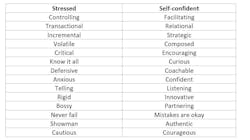Self-Confident Leadership Shines in Stressful Situations
Stress has become a dirty word, so it’s probably worth pausing to examine our broad prejudice against it. There is no doubt that stress can be harmful. We have long known that toxic stress leads to hypertension, heart disease and increased death rates. Newer research shows the correlation between traumatic stress and a range of other diseases, both physical and mental.
But an appropriate amount of stress, or “stretch,” is essential for organizations. Whether we look at the strategic need to continuously reinvent ourselves or the operational need to re-engineer for efficiency, we are always competing. The question should not be how to remove stress from our organizations, but how to embrace the challenge to compete in a way that removes the toxic elements. And this is where self-confident leadership shines.
Great Leaders Help Teams Deal with Stress
Many years ago, while working with teams at one of the big strategy consulting firms, I noticed how the more self-confident leaders helped their teams find a constructive way of dealing with the often-extreme stresses of that work. Ever since then I have seen the correlation between a leader’s confidence and the characteristics that bring about high performing teams.
The Self-Confident vs. Stressed Leader
While we use personality tests in the workplace as a way to understand and build respect—e.g., introvert, extrovert, dominant, influencing—there are two broad styles that we can simply label “self-confident” and “stressed.” These two types link to the Attachment Theory of personality.
In the table below, we list the behaviors associated with these styles. The behaviors vary in degree from person to person and relative to the level of situational stress. No one is immune to the forces of stress, and even the most confident types experience doubt and anxiety at times.
How Do These Styles Impact Others?
I hope we all know what a great experience it is to work with a calm and confident leader who values our input; similarly, how unpleasant and unproductive it is with a stressed-out boss. Here are some more specifics around the impact of these styles.
Anxiety and Engagement
A secure leader helps the team regulate negative emotions associated with shooting for high performance. Fear of failure, fear of rejection, frustration with progress and blame are all common aspects of a team’s emotional underbelly. An important part of the leader’s role is to provide reassurance and calm so that the team members feel safe enough to step up to the challenge.
Ideation and intelligence
People clam up when they feel that their ideas are not welcomed, or worse, will be harshly judged. It is the leader’s role to create an environment where team members are liberated to bring their full creativity and intelligence to the group effort. Crucially, team members need to be able to question the authority of the group and their boss. Too often, groups continue down a path knowing that it makes no sense because they are too fearful to challenge the status quo
Focus
All great efforts include a dizzying backlog of things to accomplish. The reality is that there are limits to any team’s throughput capacity. The nature of stress and stressed-out bosses is to let the lack of focus run amok and to simply demand results. A more helpful approach is to engage in a review of the backlog with the team and to energize the team’s effort around the most important priorities. Priorities often change, so this exercise needs to be repeated frequently.
Learning & agency
One of the outcomes from unhelpful stress is that people disengage and give up. Whenever we take on a significant challenge, we can guarantee that we will have to live with the fear of not succeeding and the need to learn new ways of doing things. An insecure leader will amplify these anxieties, leaving team members fearful of revealing weaknesses. A secure leader will acknowledge the problems, partner with the team in finding solutions and help the team find their own courage.
So What Should We Do?
One of the downsides of using personality tests is that we can label leaders as certain types—as though they have no choice. But just as the introvert can become a world-class public speaker through practice, so, too, the easily stressed leader can become more self-confident through working on themselves and their behaviors. Here are some ideas to try:
Recognize your stress response:
Stress is both an immediate and enduring response. But it also sneaks up on us by disguising itself as “in charge” when in fact it has short-circuited the rational brain with adrenaline and has us looking for enemies. The important first step is to recognize and name it as such. Signs of stress include: irritability, anxiety, chaotic thinking, no sense of humor, headaches, neck and shoulder pain and stomach issues.
Embrace stress:
Much like the example of the introvert who decides to become a good public speaker, the decision to embrace the challenge is transformative by itself. One fascinating study involving 30,000 participants over eight years showed that people who did not consider that stress was bad for them showed none of the co-morbidity of other participants. It helps to remember that stress is not a reaction designed to harm us but to help us respond to a threat.
Regain a better perspective:
Cognitive behavioral therapy has this marvelous term, “chaotic thinking,” which so perfectly describes how our stressed brains work. We seem to identify and sensationalize all the potential negative outcomes, leading to a frenzy of anxiety. The good news is that we have a choice. In the immediate term, take a deep breath, go for a walk, focus on nothing but the inhale and exhale of our breathing for 20 minutes. Over time, adopt good personal care practices like exercise, eating and sleeping well, and making time for hobbies, friends and loved ones.
Go hard on the problem, easy on the person.
The challenge for many of us is that we revert to an old-school command-and-control style when we feel the pressure to deliver on a tough project. We have this sense that we need to “lean in” more, and we confuse being hard on the problem with being hard on people. The solution is to turn this around. Don’t be shy about respectfully elevating the challenge, highlighting the implications and the need for change. Then come back to the list of self-confident behaviors above.
As leaders, we want our teams to embrace the need to compete, to find the courage to face that stressful challenge and to feel psychologically safe enough to share and review the creative ideas that will help us win. A self-confident leadership style will help the team step up to these healthy stresses. It can galvanize the team and energize them to become fearless competitors.
Based in the San Francisco Bay Area, Chris Morgan is an experienced and trusted executive coach. He is a Partner at Morgan Alexander, and co-founder of Listentool, a real-time feedback software solution.
****To comment on this article, please scroll down past story recommendations to "Voice Your Opinion."

